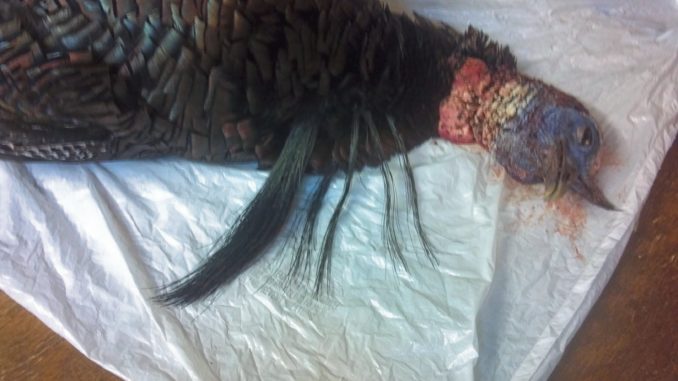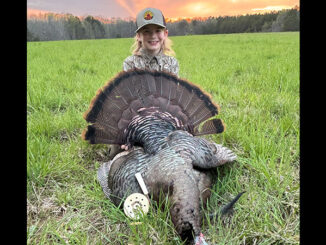
Caldwell hunter takes biggest of his “Three Amigos” on April 17
Veteran turkey hunter Brian Sykes of the Caldwell community in northeastern Orange County has had little trouble filling his tags in recent season, but a gobbler he took two weeks ago is a first for him: a 5-bearded bird that ranks in the top 10 all-time in North Carolina.
Jim Flynn, a scorer for the National Wild Turkey Federation, came up with a total score of 133.0175 points for the “non-typical” gobbler, ranking it No. 10 all time among North Carolina turkeys.
The bird, which weighed 22.28 pounds, featured a total beard length of 40.l5 inches created by individual beard lengths of 9¾, 8¼, 8, 7½ and 7 inches. The gobbler’s spurs were 1½ inches long.
The gobbler was the biggest of three that Sykes had nicknamed the “Three Amigos.” He and his sons tried their best to kill them during the 2012 and 2013 seasons.
“These three gobblers were always together,” he said, “and they ignored hens and calls. I’ve seen them walk out of a field full of hens, and the hens followed them. They showed no interest.
“I was starting to wonder if these birds were living alternative lifestyles because they wouldn’t come to hen calls — yelps, cutts, purrs or clucks. They stayed together in one clover patch and were uncallable.”
That changed the evening of April 16 when Sykes, 36, found the three birds leaving their clover field going into a wood lot to roost.
“My son, Austin, and I had seen him several times. We looked at him from a distance with binoculars and thought he was a double-beard,” Sykes said. “They were roosting in some hardwoods along a creek bottom.
“The next morning, Austin and I split up; each of us took one side of the woods.”
The three turkeys first walked past Sykes’ son, but he didn’t risk a shot because they wouldn’t come closer than 50 yards before he had to leave the woods and go to school.
The older Sykes gave up on the birds and headed home, but from his house that afternoon, he watched them feed in a nearby field.
“They went into the woods, not showing any interest in about seven hens in the field,” Sykes said. “I knew the lay of the land and was able to sneak around to the backside of those woods.”
Once he reached a likely ambush spot, Sykes used hand clippers to nip off a few branches and small trees and stuck their bases into the ground in a semi-circle around a tree, creating a blind.
“I waited maybe 45 minutes then made a few soft yelps and purrs,” he said. “They, of course, didn’t answer.”
Some time later, the birds showed curiosity at Sykes’ calls and came closer for a peek at the hen they thought they’d heard.
“I had one hole to see through,” he said. “I was pretty much in shock they came to me. I was actually getting ready to leave when I saw them and was fixin’ to shoot the first gobbler, but he walked past the hole so fast I had to shoot the second one. It turned out I chose the right one, the one with multiple beards.”





Be the first to comment